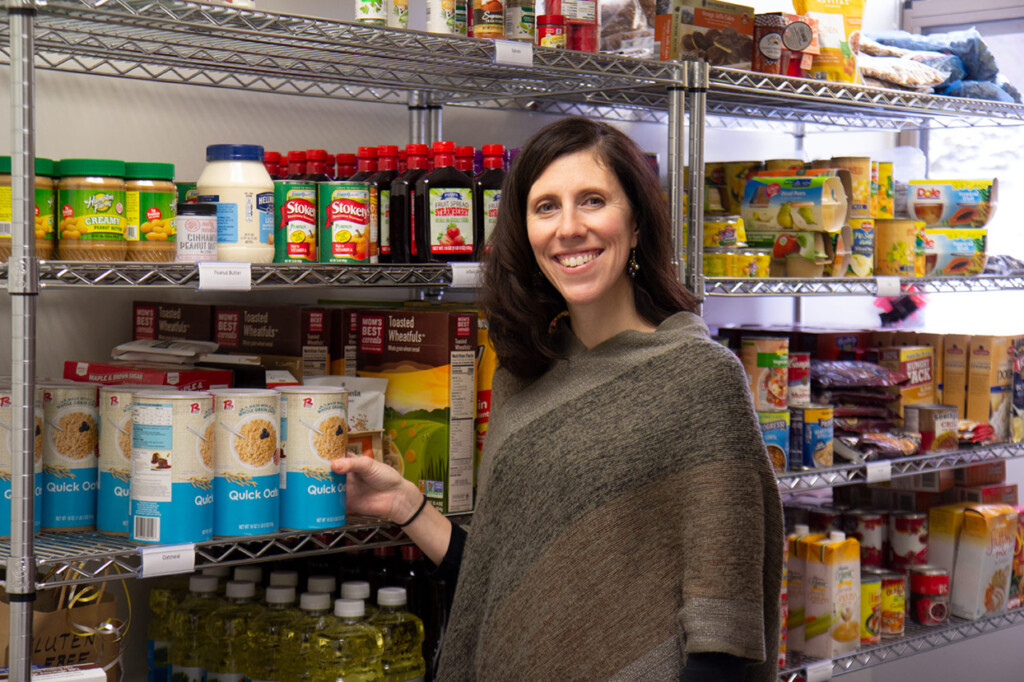Tucked away in the basement of Bray Hall is a small room, accessible yet private, with metal shelves and plastic bins filled with non-perishable food items for students who are not getting enough nutritious food on a daily basis. Food insecurity among college students is a growing problem and, on the ESF campus, leaders are working to alleviate this stress for students struggling with it.
The food pantry, Beth’s Bounty, is named in memory of Beth Ann Newkirk, an ESF student who died as the result of a house fire on Buckingham Avenue in Syracuse in June 2019. Newkirk transferred to ESF in the fall of 2018 and was working toward a degree in environmental and forest biology.
At the time of her death, Newkirk was a work study collections intern at ESF’s Roosevelt Wild Life Collections. In the months following her death, the College received a number of financial donations in her memory. In speaking with her family, ESF’s leadership learned that Newkirk struggled with food insecurity and made regular use of the Syracuse University food pantry in Hendricks Chapel.
As part of Governor Cuomo’s “No Student Goes Hungry’’ initiative to address food insecurity on SUNY and CUNY campuses, discussions were already underway regarding the creation of a food pantry at ESF, according to Dr. Anne Lombard, vice provost and dean for student affairs. The desire to do something to honor Newkirk pushed the pantry idea forward. “It just made perfect sense for us to do this in her honor,’’ Lombard said.
Much credit goes to Laura Crandall ’05, director of student involvement and leadership. She suggested the space in the basement of Bray Hall, developed a relationship with the Food Bank of Central New York, recruited student volunteers and secured the necessary shelving and storage bins. “It all just kind of came together,’’ Crandall said.
Exact data is hard to come by, but it is estimated that one in three college students nationwide is food insecure. Food insecurity is defined as not having the money and resources to afford nutritious food on a consistent basis. Experts say the problem is growing and tied to the financial strains of tuition, housing, textbooks and other expenses.
In one survey, nearly half of 86,000 students at two- and four-year colleges and universities nationwide identified as food insecure at some point in the previous year. More than a third of students surveyed said they skipped meals or reduced the size of meals because they couldn’t reliably afford food.
What does hunger on campus look like? It means not being able to afford basics such as milk, eggs and bread. It means your stomach might growl loudly during class or in the library — and it means not knowing what and when your next meal will be. It means not being able to concentrate on your studies because both your belly and brain are hungry and your anxiety about food is constant.
Environmental studies major Donnella Vivian Monk ’20 who has been involved in helping to launch the pantry, said she experienced food insecurity during significant parts of her life while growing up in Cleveland, Ohio. Even with loans and part-time jobs, she said, she was a regular at the Salvation Army food pantry in Syracuse and the Syracuse University food pantry when she arrived at ESF.
“I understand the importance of access to pantries, hot meals and (food) drives because without them, I would not be here today,’’ said Monk, who has used the pantry several times since it opened. “I believe with food, I am a better student. I also know that it is hard to afford your everyday needs. Food insecurity is a threat to the success of a student because it affects your body through lack of appropriate nutrition. Without nutrition, students are less likely to succeed, which is why a food pantry on campus is vital.”
Emily “Em” Rodriguez, a junior from New York City, has experienced food insecurity periodically and signed up to volunteer at the ESF food pantry as soon as she learned about it. She has taken advantage of the SU food pantry in the past and said she worked several jobs this past summer and was able to set aside money for food this year. “This is a state school, not exactly for rich kids,’’ Rodriguez says. “I have seen students eat nothing but ramen noodles and pasta. You need more healthy food, so you are able to pay attention and succeed.’’
Beth’s Bounty is open to any student who is experiencing hunger and/or struggling to obtain food and eat regularly because of financial hardships. The pantry is stocked with rice, pasta, canned fruits, vegetables and legumes, soups, cereal, cooking oil, herbs and spices and other non-perishable items from the Food
Bank of Central New York. The pantry also offers some household and personal care items, such as dish soap, laundry detergent, dog food, shampoo and feminine hygiene products.
ESF students can visit the pantry once a week during drop-in hours (or by appointment). Students are asked to fill out an intake form each visit and bring their own shopping bags. The pantry is open 9 a.m. to 5 p.m. Monday to Friday and staffed by members of the honor society Alpha Xi Sigma, who donate their time.
Crandall says Beth’s Bounty is in its formative stages and they are figuring things out as they go. She would like to see some gluten-free, allergy-sensitive and ethnic foods on the pantry shelves. In mid-September, she said, about 20 students a week were using the pantry. She expects that number to grow as word about the pantry spreads.
“This, in my opinion, is just the beginning,’’ Crandall said. “It’s win-win. I really haven’t heard anything except, ‘Wow, this is awesome.’ I think people are really just appreciative.’’
Margaret McCormick is a freelance writer in Syracuse.



